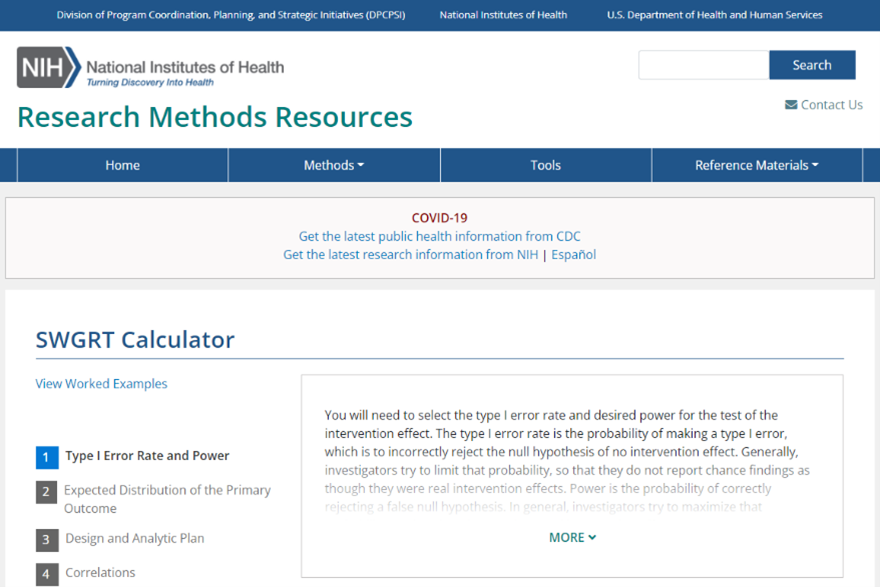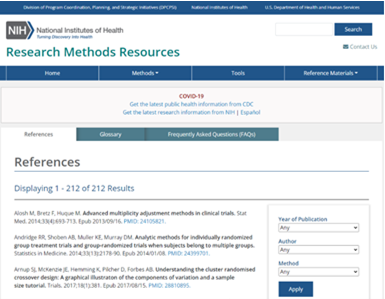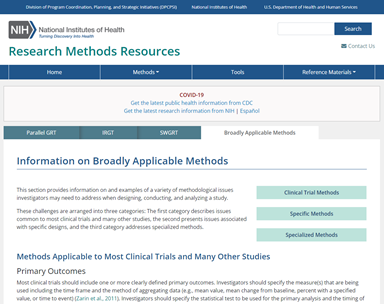
Director, Office of Disease Prevention
When we highlighted the redesigned and expanded NIH Research Methods Resources (RMR) website last year, we hinted there would be more yet to come. We have been busy over the past several months and are happy to announce you can now find helpful resources for stepped wedge group-or cluster-randomized trials (SWGRTs) and more than 15 other study designs and methodological issues on the RMR website.
Launched in 2017 by the NIH Office of Disease Prevention (ODP), the RMR website was developed as one in a series of initiatives to enhance the quality, accountability, and transparency – in short, the rigor – of NIH-supported clinical trials. The site initially focused on trials that randomize and/or deliver interventions to groups or clusters and featured a sample size calculator for parallel group- or cluster-randomized trials (GRTs). In 2021, a sample size calculator for individually randomized group treatment (IRGT) trials was added to the site along with a more modern look and user-friendly features like the ability to filter references by year, author, and type of research method.
This year, we expanded the RMR website further still. A section specific to stepped wedge group- or cluster-randomized trials (SWGRTs), including a sample size calculator, has been added to the site. It provides an overview of the SWGRT design, answers to frequently asked questions, and links to important references (Figure 1). These new resources make it easier for researchers who employ this trial design to strengthen their sample size and statistical analysis plans based on current trends.
Inspired by the previously available GRT and IRGT calculators, the new SWGRT sample size calculator (Figure 2) is a user-friendly tool to assist investigators with cross-sectional, open cohort, and closed cohort designs. Tutorials are available for each aspect of the sample size calculation and results can be downloaded to work with offline. Examples also illustrate what formulas the sample size calculators use to arrive at the results.
Following an extensive review of publications to identify important recent contributions to the literature since 2017, the site now includes more than 200 references in total, covering not just GRTs, IRGTs, and SWGRTs, but also methodological topics across a wide array of other study designs. This updated reference list is a convenient resource for current research trends (Figure 3). Many of the references are embedded as inline citations throughout the site and within the three sample size calculators, providing added context to the material.
Finally, because methodological issues arise in virtually all types of research, the RMR website now provides information on several methodological challenges investigators may face when designing, implementing, and analyzing their studies (Figure 4). The result of a collaboration of statisticians and methodologists across the NIH to help improve research methodology more broadly, this new material includes brief overviews of these issues, links to important references, and several pragmatic examples.
The material on the RMR website is relevant to both randomized and non-randomized trials, human and animal studies, and basic and applied research. The information provided represents current thinking among biostatisticians and other methodologists at NIH regarding best practices for issues that may arise when working with different study designs. Investigators are encouraged to evaluate whether this information is applicable to the studies they are considering and to make use of it where appropriate. This information is not part of the instructions for any application for research support from NIH and investigators are not required to use it. Those who wish to apply for research support should always refer to the general application guidelines for NIH funding and to the specific application instructions in the funding opportunity announcement to which they are applying.







0 Comments